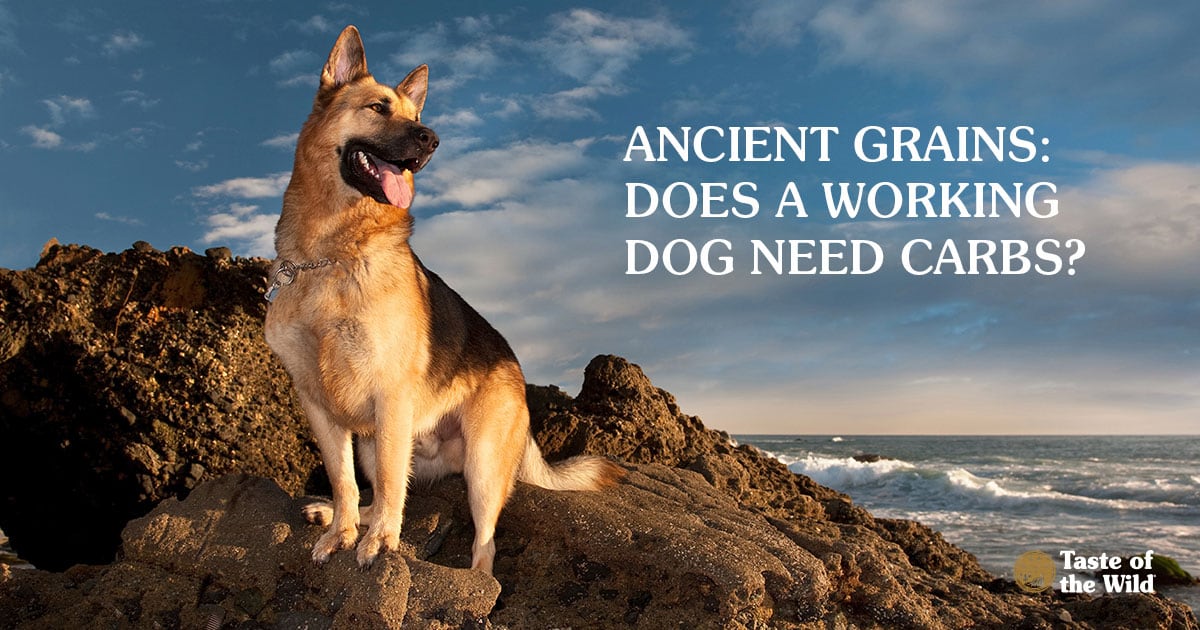Does a Working Dog Need Carbs?
Category: Working Dogs

Is your dog considered a “high-energy” dog? Is he or she getting the energy they need from the food they consume? While some pet parents believe that a high-protein, moderate- to high-fat, low-carbohydrate diet is ideal for all working and sporting dogs, that’s not always the case.
If you have a canine athlete or service dog, it’s important to carefully consider their energy needs when selecting their food. Dogs who work hard for long periods of time will likely benefit from that high-protein, moderate- to high-fat, low-carbohydrate food that provides energy from fat sources. However, if your hard-driving pup is more of the “short-burst” variety, like service dogs or those who compete in sprinting or activities that include medium intensity for 30 minutes or less at a time, a balanced diet that provides moderate amounts of protein, fat and carbohydrates may offer more of what they need.
Nutritional needs vary from job to job
Fat, carbohydrates and protein provide the energy that your dog needs, whether he or she is tracking a lost individual, herding sheep, sniffing out digital crimes, or working hard on another type of job. The canine body’s preferred energy source — dietary fat or carbohydrate — depends on the type of activity being performed. Yet even hard working dogs benefit from carbohydrates in their food.
Your dog’s breed, age, gender and reproductive status, as well as the type of activities performed, determine whether a particular energy-dense performance food supplies the right nutrients. The characteristics of the food itself play a role, too.
While the nutritional requirements vary widely and are determined by the duration and intensity of activity performed, the type, duration and intensity of physical activity also influences which ratio of protein, fat and carbohydrates will benefit your dog. Some active dogs will benefit from a diet designed specifically for athletic canines. Others can be well-maintained on a high-quality adult maintenance dog food.
Fat and carbohydrates are preferred by hard working muscles
To appreciate how dietary carbohydrates add value to working and sporting dog nutrition and performance, it helps to know more about this nutrient category and its various roles in the body.
Carbohydrates are used for energy, including energy for exercise, or “work.” While certain amino acids from protein can be converted to energy during exercise, fat and carbohydrates are actually the preferred energy sources for working dog muscles.
Fat, in the form of free fatty acids, is the preferred fuel for muscles when dogs perform low-intensity aerobic (requiring oxygen) exercise, which is the activity type associated with endurance activities like search-and-rescue missions, sled pulling and hunting. In fact, dogs get approximately 70 percent to 90 percent of their energy for endurance-type work from fat metabolism. Although only a small amount of energy is obtained from carbs, some glycogen metabolism is always necessary for ongoing free fatty acid metabolism during aerobic activities.
As exercise intensity increases, as it does during sprinting, working canine muscles shift to more anaerobic (without oxygen) metabolism and draw on muscle and liver glycogen stores for energy. A dog’s body uses dietary carbohydrates to help maintain and replenish glycogen stores.
Although dogs don’t have a dietary requirement for carbohydrates, they do have a metabolic requirement for glucose. One of the simplest carbohydrates, glucose is the carbohydrate form that circulates in blood and is the primary carbohydrate used by the body’s cells for energy. In fact, a constant supply of glucose is necessary for the central nervous system to work properly.
Glucose is used during aerobic and anaerobic metabolism. What glucose isn’t used immediately for energy can be stored in the liver and muscles as glycogen. It can also be converted to and stored as fat. When blood glucose levels are low, glycogen in the liver and muscle can be used to supply fuel to cells. And glycogen present in heart muscle provides a valuable emergency source of energy for the heart.
When adequate carbohydrates are provided through food, protein remains available to provide indispensable (essential) amino acids, repair and build tissues, and support a healthy immune system rather than being used for energy. Although dogs can use certain amino acids to produce energy, the process is less efficient than using dietary carbohydrates because the body needs to process and remove nitrogen waste after breaking down amino acids.
Complex carbohydrates contribute dietary fiber that supports healthy gastrointestinal tract functions. Dietary fiber isn’t considered an essential requirement for dogs, but it does encourage growth of beneficial bacteria in the colon, help promote regular bowel movements and regulate colon pH. Bacteria in the large intestine (colon) are able to break down certain types of fiber even if dogs don’t directly digest dietary fiber. Fiber fermentation produces short-chain fatty acids that are an important energy source for the cells lining the gastrointestinal tract.
Ancient grains provide carbohydrates
The chief carbohydrate source found in most commercial pet foods is starch, the energy storage form used by plants. Ancient grains such as sorghum, barley, quinoa and millet, along with grains such as rice (brown and white), corn and wheat, are ingredients used in pet food to provide carbohydrates in the form of digestible starch.
These same ingredients also contribute indispensable amino acids, essential fatty acids, minerals and vitamins to pet foods.
Questions? Ask your veterinarian
As always, any time you have questions about your performance dog’s nutrition, talk with your veterinarian, who can not only evaluate your dog’s body condition but determine how much energy (calories) your dog should be consuming daily.
The information in this blog has been developed with our veterinarian and is designed to help educate pet parents. If you have questions or concerns about your pet’s health or nutrition, please talk with your veterinarian.




